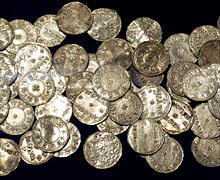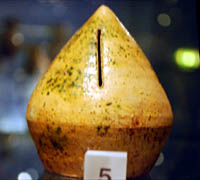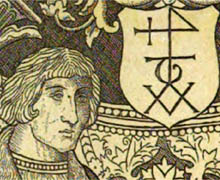The processes of medieval urbanization and of the commercialization of society
were intimately connected. But it was not simply that an expanding population
was building demand and pushing a growing proportion of the overall population
into towns. People were becoming more accustomed to obtaining their necessaries
by buying them, to having access to a wider range of goods (beyond what
was required just for subsistence), to selling goods themselves to earn at least
a portion of their livelihood, and to manufacturing a volume of products
considerably surplus to household needs, specifically for sale to a wider clientele
than just neighbours – in some cases consumers well beyond the reach of
the local producer. This process of commercialization fostered specialization
and productivity and thereby contributed to conditions favouring population growth,
urbanization, and greater complexity in social structure and social relationships.
Those in specialized occupations were more dependent, in a variety of ways, on others;
this itself encouraged the growth of large, well-organized communities encompassing
a wide range of necessary productive and distributive agents and agencies,
somewhat as ancient philosophers had outlined it
when explaining urbanization.
England was well on its way to becoming "a nation of shopkeepers" by the close
of the Middle Ages, though this concept does not do justice to the role of
the long-distance merchant in the development of the national economy.
The term 'traders' encompassed, certainly by the High Middle Ages,
a wide range of commercial actors, just as it does today, from the humble
itinerant pedlar, through both generalized and specialized retailers, to
the wealthy wholesalers who were the core clientele of fairs, risked
their merchandize and sometimes their persons in periodic overseas voyages
(not for nothing was Mercury the Roman god of commerce), and invested
some of their time, creative effort, and wealth back into the towns
whose commercial advantages had helped make their prosperity possible. As the
Middle Ages progress we encounter a growing number of men with surnames (though
not always reliable evidence) or occupational descriptors indicating them merchants
or chapmen, though the scale of their operations often eludes us. Even men who,
at first glance, we might classify as pedlars may have been larger-scale operators
than we would guess, as for example the
Grimsby burgess Robert le Peddere who, in 1277,
was in sufficiently advantageous a position to obtain from the king a life grant of
exemption from tolls on his merchandize in all the cities, boroughs, and towns of
the realm; he probably won this favour through commercial services to the king,
for in the same year we see him taking fish to Chester to feed a royal army about to
embark on an invasion of Wales, and in 1282 he did the same. He may have specialized
for some time in supplying the army, for in 1266 the king had granted him a year's
exemption from royal tallages assessed on his home town. Evidently Robert had
somewhat outgrown his surname.
While it is difficult to conceive of a town that lacks regular commercial activity,
whether intra-mural or suburban, neither trade nor industry were purely, or even
primarily, urban activities, merchants and markets by no means uniquely or inherently
urban characteristics. In the tenth century English kings could try to
restrict to towns at least
major commercial transactions and the production of coins that facilitated
such transactions. Henry I made an effort, in 1120, to uphold this tradition
by limiting water-borne commerce in Cambridgeshire to the county town;
Henry II reinforced his grandfather's approval of Nottingham's Friday-Saturday
market with a requirement that no-one
of that shire nor adjacent Derbyshire could trade in any other market on those days
– a stipulation that fits more comfortably into the charter context than
Richard Britnell's suggestion ["English Markets and Royal Administration before 1200,"
Economic History Review, 2nd ser., vol.31 (1978), p.196] that the king was
instead instructing outsiders to restrict their trading at Nottingham to official
market days – and on another occasion he ordered that all foreign merchants
visiting Lincolnshire should conduct trade only at Lincoln. Both kings were motivated
by the desire to ensure tolls were not evaded. But from the mid-twelfth century,
and particularly during the thirteenth, when both towns and
manorial markets
were proliferating, such a restrictive policy became increasingly unrealistic;
indeed, it could never have been possible to enforce effectively, given
the widespread distribution of raw resources and of manufacturing activities,
and the natural inclination of buyers and sellers to conduct business
wherever necessity or advantage dictated. By the Late Middle Ages
the English economic landscape had altered significantly from its pre-Conquest appearance.
We do not need to fall into the trap of economic determinism to recognize that
towns had an almost indispensably important role in the economic growth
of medieval England. On the one hand, as aggregators of population, key nodes
in the transportation network, attractors of travelling merchants, and yet not
(for the most part) being generators of large quantities of raw materials,
it was natural and indeed one defining characteristic of towns that a sizable
proportion of the residents would support themselves, in part or in whole,
by adding value to raw materials; that is, by applying skilled labour
to transform them into more usable products – butchers, bakers, weavers,
tanners, shoemakers being just a few examples falling under this umbrella.
In the larger production centres growing specialization of labour was not only
feasible but necessary. On the other hand, towns were key distribution nodes,
both of raw products brought in from rural areas as well as of their own
value-added industrial products and, to a lesser degree, those of artisans
from at least the surrounding region. Furthermore, towns were centres of
consumerism in their own right, the great percentage of urban residents being
wage- or profit-earning and needing to acquire from others a high proportion
of their necessaries.
Towns could be given privileges and institutions that helped foster their advantageous
position as foci for commerce and the industry that helped fuel it; though competition,
both within and between towns, rather than monopoly would always be the keynote
in medieval urban history. However, although there came to be a degree of competitiveness
between town and countryside, the complementary aspect of their relationship is
the more significant. Urban traders and artisans needed reliable and economic access
to the raw materials that came from outside, while the existence of towns encouraged
the production of larger volumes of raw materials than could be consumed by
a rural producer's household and neighbours. It should be no surprise that most
non-coastal towns were surrounded by fields and pastureland, much of it coming
into the hands of townspeople themselves; however, these suburban resources were
rarely if ever sufficient to fully meet urban needs, and raw materials had to come
from further afield. Assuring uninterrupted lines of supply of affordable
necessaries – both for domestic consumption and for use by local industries – was
a key challenge for civic authorities. The interdependence of town and
countryside – or hinterland, as called by urban historians – has been
a major theme in economic studies of recent decades. It is not necessary
to see either component as the driving, or more potent, force; but there was
a certain tension between the two.
What is important is the way they interacted with, and impacted on, each other.
One of the most basic views of this 'urban field' – a term used by geographers
to denote the area of influence around a town – is the locative surnames acquired
by many of the immigrants who settled in towns, to distinguish them from other individuals
of the same Christian name; most such surnames refer to villages within the hinterland,
while a smaller number point to a catchment area of villages and small towns
in regions surrounding the hinterland, and an even smaller number from one or
more zones further afield, some from outside England (see below). The concentric zones
of the urban field are likely to reflect, albeit imperfectly, the trading links of
the town at the centre, and (to a perhaps overly generalized extent) the types of
trade conducted: the inner zone being characterized by small-scale trade particularly
in necessaries and the transfer of individual farmers' produce to the nearest
distribution point; the central zone by secondary distribution points serving
wider consumer groups, with trading both in large and small scale of specialty
or higher-quality products; and the outer zones by wholesale transactions or
the acquisition of luxury goods. We might thereby conceptualize medieval commerce
as a somewhat hierarchical network with multiple hubs – notably rural markets,
fairs, ports, and towns – each hub surrounded by its concentric zones of
trading activities, and with sets of zones overlapping one another. These hubs
performed essentially the same functions in terms of first assembling commodities
and then re-distributing them, in some cases following a value-added transformation,
though on different scales.
This pattern of hubs, or 'central places', as one economic theory characterizes them,
overlaid another network, of primary and secondary transportation routes
(both land and water), each of the two patterns helping shape the other.
Keeping rivers free of obstructions and harbours dredged, supplying the town
with a serviceable quayside, building
causeways through marshy terrain,
maintaining bridges in good repair,
assuring that suburban and country roads were safe and passable, and
paving and cleaning urban streets
and marketplaces were growing preoccupations of borough governments during
the Middle Ages; a reliable transportation infrastructure facilitated
the movement of bulk goods, influenced the direction that itinerant traders
would take, and reduced the costs of doing business by making travel less
time-consuming or risky. Awareness of such needs may be inferred from
the Leges Henrici Primi,
reflecting laws promulgated prior to the twelfth century, which show
concern for the viability of the roads.
Borough leet courts were empowered to deal with
residents accused of damaging or impeding streets or rivers. In the Late Middle Ages
a number of merchants included among their charitable bequests modest (though
sometimes larger) sums in support of the transportation infrastructure that had
contributed to their prosperity (see for example the wills of
John Burghard,
Robert Chichele,
John Welles, and
Nicholas and Margaret Blakburn.
Given a well-maintained road and river network, traders in possession of
transport – be it boat, cart, or packhorse – and who were familiar with
the timing of commercial gatherings and the distances between the network hubs
could plan out their business itineraries cost-effectively. The ancient Roman potter
Zosimus wrote down, on the wall of his shop in Pompeii, an organized list of the days
when markets were held locally and at seven other towns in central Italy, and medieval
traders doubtless had something similar, if only held in memory. Carrying bulky goods,
such as grain, fuel, or building materials, by water was much cheaper than by road.
Although it is a matter of debate among historians just how navigable some rivers
remained into the Late Middle Ages, it is clear that the river system helped
with the long-distance distribution of large or heavy cargoes, allowed
network connections that would otherwise have been difficult, and was a boon
to urban development – most large inland towns being situated on rivers.
The evolution of this commercial/transportation network was very complex;
as Christopher Dyer has noted: "often change emerged from the combination
of thousands of uncoordinated actions, involving people at all levels".
[Making a Living in the Middle Ages, p.7] But the development of
such a network provided England with a commercial vitality that brought wealth
to mercantile communities without cities becoming as large, populous, and
economically sophisticated as those in other parts of Europe. And this national network
was well tied into the larger network of international trade.
Tracing the growth of this mercantile vigour is not without its challenges.
It is not easy to gauge the extent of commerce in the Anglo-Saxon period.
The population was then relatively small and geographically dispersed; by
the close of that period still some 90% of the population was living in rural settlements.
Many of the villages were probably able to meet subsistence needs through what
was produced locally or obtained by exchange with neighbouring communities,
the latter carried out in some cases through informal market gatherings.
Even many of the towns existing in this period may have been able to supply
the victuals needed to support residents from the agricultural and pastoral lands
within and surrounding those places. There was not the same need for
specialized occupations that later came about; workers who did specialize
in some craft, trade, or service certainly existed in the Anglo-Saxon period, but were
rarely so numerous or productive that we can think in terms of regular, systematized
long-distance trade in bulk goods, nor so competitive that there would yet have been seen
any need for industrial regulation. Although the very existence of a class of tenants
known as burgesses can be used to argue
for the growth of the number of individuals making a living primarily through trade
and/or industry, it is not until Domesday Book that we have written evidence
to supplement that from archaeology, and even
Domesday's evidencecannot give us
a sense of numbers.
While there is documentary evidence
of marketing and supportive activities (e.g. minting) in the Late Anglo-Saxon period,
the evidence for kings or local authorities capitalizing on commercial activities
through the imposition of tolls is patchy,
with the clearest statement coming from London,
whose growing importance and convenient and sheltered location, deep within
the Thames estuary, for ships crossing the North Sea or English Channel made it
attractive to foreign merchants. Foreign trade was taking place through other
coastal wiks and ports, but we rely mainly
on archaeology for our knowledge of it. Nor did the laws of the Anglo-Saxon kings
pay much attention to commerce except, notably, coinage regulation and the concern
that trade in livestock encouraged cattle-stealing. Even the attempts
to legislate restriction of buying and selling (other than minor transactions)
to towns may well have been aimed at combatting sale of stolen goods.
What was important in these laws was that transactions be witnessed by officials
or other trustworthy third parties, and lawful transactions probably occurred
wherever such witnesses could be found; there were not necessarily dedicated marketplaces,
although conveniently located open areas may have become used regularly for trading.
Churchyards were likely among the favoured spots, as they certainly were in
the early post-Conquest period; also areas in front of ecclesiastical buildings,
or crossroads, both of which tended to be located at central points in towns,
as for example at Maldon,
Ipswich, and Norwich.
Landing-points for water transport were equally likely to attract traders
and eventually develop into marketplaces, as at Yarmouth
and Lynn. Alternatively, trading might simply
take place in one or more of the main streets of a town – perhaps particularly
in towns established before need was felt for a large dedicated area – and
these, or some part thereof, would become the official marketplace; such was the case
at Colchester and to some extent at London (which was
so built up that there were few larage open spaces to serve as marketplaces) and York.
It may be significant that whereas planned towns of the thirteenth century could be
expected to incorporate an ample area designated as the marketplace, as at
New Winchelsea, the town built in
the late eleventh century as an adjunct to the construction of Battle Abbey shows
no provision for any such facility, and trading may have taken place along
the High Street leading from an open space,
between the abbey entrance and the parish church opposite, to an area later used
as a livestock market. The monastic boroughs of Evesham and St. Albans
similarly seem to have held their markets in an area beginning in front of
the abbey gateway and stretching into the High Street. In later centuries
reminders that the conduct of trading was under supervision of local authorities
were provided by building town halls (which often incorporated courtrooms
and even gaols) within or on the edge of marketplaces and by setting up pillories
within marketplaces, while the erection of market crosses
reminded traders that all their dealings were carried out under, ultimately,
divine supervision.
We should not conclude from the relative silence of documents produced
in pre-Conquest England that long-distance commerce – whether within England
or to foreign parts – was negligible. The existence of a commercial network,
comprising production centres – both of raw materials, such as wool,
and of items manufactured in quantity, such as ceramics, bone or
metal products – ports and inland markets, mints, and maintained
transportation routes is suggested by documentary and especially archaeological evidence
from the Late Anglo-Saxon period, and perhaps earlier. But unsettled conditions
within England did not favour rapid development of inland commerce. It was
a very gradual process, partly the outcome of conscious development and limited
royal regulation, but more the consequence of human nature. As
Richard Britnell has pointed out
"The market order which figures so large in modern society has, from one
point of view, been created piecemeal over many centuries by buyers and sellers
seeking to reduce the costs of trading." [Commercialisation of English Society, p.10]
This process was given impetus and shape by the new landlords installed following
the Conquest – or, more accurately, by their descendants, looking for ways
to exploit their new estates for better fiscal yield. This phenomenon prompted
increased reclamation of agricultural land from forest and marsh, population expansion
as more land became available, growth in market demand both at the upper
and lower levels of society, and creation of a surplus of produce and people
that made it feasible and profitable to found
new towns, as foci both for the distribution of raw resources and for
the manufacture and distribution of secondary products made from those resources.
Such towns provided a range of new revenues for the landlords. The smaller towns, and even
some that were mid-sized, perhaps continued to be able to supply most local victualling needs
from lands in the close vicinity, although the establishment of new manorial lords, castles,
monasteries, and later friaries, as well as the gradual growth of a mercantile group within
urban society, fuelled demand for wine, spices, cloth, and other goods that had to
be imported from further afield.
At the same time that landlords were intervening in the process of development
of trading facilities, the central government was also more actively seeking
to establish controls over commerce, both for purposes of financial gain and
as part of the larger effort to assert and extend regal power throughout the realm.
One of the facilities that the town-founders of the twelfth and thirteenth centuries
wished to provide to their burgesses was a formal market. The Crown had been trying
to claim a monopolistic prerogative to license new markets or fairs,
together with associated jurisdictional rights; but this claim was only
widely accepted from the latter half of the twelfth century. Grants of markets
by the king or mesne lords are documented as far back ast the Late Anglo-Saxon period,
but without any jurisdictional rights specified. In some cases the documentation
is questionable, such as the claim of Evesham abbey's chronicle that in 1055
the Confessor granted the monastic borough a port
(in the sense of commercial privileges) and a market, backed up by a confirmation
in a writ of the Conqueror now considered a later forgery, perhaps produced
in conjunction with the establishment of a 'new borough' resulting from
twelfth century expansion of the original urban foundation.
Through the royal licensing mechanism –
essentially the grant of a franchise to seigneurial lords to be implemented
within specific locales – the legalistic concept of a market came about.
Already royal laws, from the Late Anglo-Saxon period on, had been pushing
the principle of standard weights and measures, based on those used at the twin capitals
of Winchester and London, but the enforcement of uniform standards
was not practicable until local authorities – whether seigneurial or
burghal – could be engaged in that responsibility, and even then it was
an uphill battle. This and other administrative obligations associated with
formal markets involved a cost to the administrator, but the volume of transactions
attracted by such markets gave rise to revenues that outweighed, or at least (if
a licensed market proved competitive) had the potential to outweigh, the costs.
Licensing of markets also enabled the Crown to control over-competitiveness (see below).
It was thus partly through the willingness of landlords to supply the growing need
for markets – and even, in parts of the country, to exceed economic requirements
and create a glut of markets that would have to compete for survival – plus the desire
of the monarchy to interpose itself in the process in the public interest (as well as
in its own), that there evolved a network of markets
distributed fairly evenly across much of the country.
Furthermore, it is primarily through the documentation generated
in relation to these interventions by landlords and kings, and the agencies who
administered commerce on their behalf, that we obtain a picture, albeit inevitably
distorted, of the development of commerce during the later Middle Ages.





